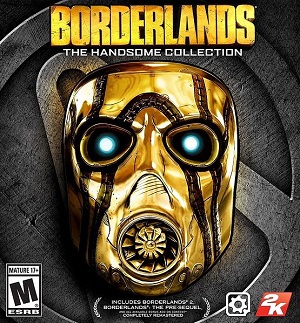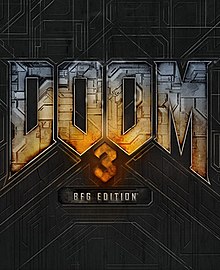
Doom 3 is a 2004 survival horror first-person shooter video game developed by id Software and published by Activision. Doom 3 was originally released for Microsoft Windows on August 3, 2004, adapted for Linux later that year, and ported by Aspyr Media for Mac OS X in 2005. Developer Vicarious Visions ported the game to the Xbox, releasing it worldwide on April 4, 2005.

Doom II, also known as Doom II: Hell on Earth, is a first-person shooter game in the Doom franchise developed by id Software. It was released for MS-DOS in 1994 and Mac OS in 1995. Unlike the original Doom, which was initially only available through shareware and mail order, Doom II was sold in stores.

Doom 3: Resurrection of Evil is a survival horror first-person shooter video game developed by Nerve Software and published by Activision. It was released for Microsoft Windows worldwide on April 4, 2005, as an expansion pack and sequel to Doom 3 and on October 5, 2005, for the Xbox video game console. The Xbox version does not require the original Doom 3 in order to play, and includes The Ultimate Doom, Doom II: Hell on Earth and Master Levels for Doom II. A remastered version of Resurrection of Evil was included with Doom 3: BFG Edition.

Doom 64 is a 1997 first-person shooter video game developed and published by Midway Games for the Nintendo 64. It is the second spin-off in id Software's Doom series after Final Doom (1996), and the fourth game in the series overall. A remaster was developed by Nightdive Studios and published by Bethesda Softworks for Nintendo Switch, PlayStation 4, Windows, and Xbox One in March 2020, and for Stadia in May 2020.

Marvel: Ultimate Alliance is a 2006 action role-playing video game published by Activision for various gaming systems. Developed by Raven Software, Ultimate Alliance is set within the fictional Marvel Universe and features many of the superheroes, supervillains, and supporting characters that appear in publications by Marvel Comics. It shares many similarities with Raven Software's previous Marvel titles, X-Men Legends and X-Men Legends II: Rise of Apocalypse, in that it allows players to select from its vast cast to create the ultimate superhero team. The game features an original plot in which the heroes of the Marvel Universe must join forces to defeat Doctor Doom and his Masters of Evil and foil their plans for global domination.

Red Faction: Guerrilla is a third-person shooter video game developed by Volition and published by THQ. It was released for the PlayStation 3 and Xbox 360 in June 2009 and for Windows in September 2009. The game is the third installment in the Red Faction series. A remastered version titled Red Faction: Guerrilla Re-Mars-tered with improved graphics was released worldwide on July 3, 2018, for the PlayStation 4, Windows and Xbox One, and on July 2, 2019, for the Nintendo Switch.

Doom is a 2016 first-person shooter video game developed by id Software and published by Bethesda Softworks. The game is the first major installment in the Doom series since 2004's Doom 3 and was a reboot of the franchise. It was released for PlayStation 4, Windows, and Xbox One in May 2016. A port for Nintendo Switch was co-developed with Panic Button and released in November 2017, and a version for Google Stadia was released in August 2020. Players take the role of an unnamed space marine, known as the "Doom Slayer", as he battles demonic forces within an energy-mining facility on Mars and in Hell.

Doom is an American media franchise created by John Carmack, John Romero, Adrian Carmack, Kevin Cloud, and Tom Hall. The series usually focuses on the exploits of an unnamed space marine operating under the auspices of the Union Aerospace Corporation (UAC), who fights hordes of demons and the undead to save Earth from an apocalyptic invasion.

GoldenEye 007 is a 2010 first-person shooter video game developed by Eurocom and published by Activision for the Wii, with a handheld version for Nintendo DS developed by n-Space. It is a modern reimagining of the 1995 James Bond film GoldenEye as well as a remake of the 1997 video game of the same name, developed for the earlier Nintendo 64 console. The game was officially announced by Nintendo at their E3 2010 conference presentation. The game was released on 2 November 2010 in tandem with another James Bond game, Blood Stone, which was also released for the DS, but not the Wii. Nintendo, the publisher of the Nintendo 64 game, published the Wii version in Japan the following summer, where it remains Wii-exclusive. It was the fifth James Bond game developed by Eurocom and their second under Activision, after the PlayStation 2 version of 007: Quantum of Solace two years prior.

F1 2011 is a video game developed by Codemasters based on the 2011 Formula One season. The game was released in 2011 on Microsoft Windows, the Nintendo 3DS, PlayStation 3, and Xbox 360, with a 2012 release on the PlayStation Vita as a launch title for the system. The game engine is based on EGO 2.0 engine.

Metal Gear Solid HD Collection is a compilation of remastered ports of Metal Gear video games released for PlayStation 3 and Xbox 360 in 2011 and PlayStation Vita in 2012. The compilation contains Metal Gear Solid 2: Sons of Liberty and Metal Gear Solid 3: Snake Eater on all three platforms, plus Metal Gear Solid: Peace Walker on the home console versions, with the individual games all branded as HD Edition. Bluepoint Games handled the conversions of Metal Gear Solid 2 and 3, while Genki worked on Peace Walker.

Skylanders is a toys-to-life action-adventure video game franchise published by Activision. Skylanders games are played by placing a character's figure on the "Portal of Power", a device that reads its tag using NFC and "imports" them into the game as a playable character, leveling them up and saving its progress on the figure to potentially be used on a different game with all its saved stats. Skylander figures are sold separately from the game itself unless you buy the starter pack. Typically, the starter pack for each game contains two or more Skylanders, a Portal of Power, the game disc and sometimes something else to show off the game's newest feature.

Just Dance is a rhythm game series developed and published by Ubisoft. The original Just Dance game was released on the Wii in 2009 in North America, Europe, and Australia.

CastleStorm is a 2013 game developed by Zen Studios for Xbox 360, Windows, PlayStation 3, PlayStation Vita, and Wii U. A remastered version titled CastleStorm: Definitive Edition was released in 2014 for PlayStation 4 and Xbox One. A free-to-play mobile version titled CastleStorm: Free to Siege was released in 2014 for Amazon, Android, and iOS. The game also received a virtual reality adaptation for Oculus Rift, Samsung Gear VR, and PlayStation VR. A sequel titled CastleStorm 2 was released on July 31, 2020.

Borderlands: The Handsome Collection is a compilation of first-person shooter video games developed by Gearbox Software and published by 2K. The Handsome Collection consists of both Borderlands 2 (2012) and Borderlands: The Pre-Sequel (2014) for PlayStation 4 and Xbox One, along with all of their accompanying downloadable content, enhanced local multiplayer, and the ability to transfer save data from their respective PlayStation 3 /Vita/PSVR and Xbox 360 versions. A port to the Nintendo Switch entitled Borderlands Legendary Collection was released in North America on May 29, 2020 along with the PlayStation 4 and Xbox One versions, which additionally includes the first Borderlands. For The Handsome Collection, Borderlands 2 was ported by Iron Galaxy Studios and Borderlands: The Pre-Sequel by Armature Studio. The Legendary Collection port was handled by Turn Me Up Games and Behaviour Interactive.

Victor Vran is an action role-playing video game developed by the Bulgarian independent development studio Haemimont Games. Victor Vran is published on Steam by EuroVideo Medien. The setting of the game resembles Gothic-fantasy fairy tale where both magic and science have a place in the world. The title was released on July 24, 2015. An updated port titled Victor Vran: Overkill Edition was released on PlayStation 4 and Xbox One on 6 June 2017, and a Nintendo Switch port was released on August 28, 2018. A version of the original game was made available for Amazon Luna on 20 October 2020.
Super Mega Baseball is a baseball video game series developed by the independent studio Metalhead Software in Victoria, BC, Canada and published by EA Sports.

Panic Button, LLC is an American video game developer based in Austin, Texas. Founded in late 2007, the studio is best known for their ports of AAA video games from other platforms to the Nintendo Switch console. Panic Button also does contract work on other platforms, including 4K updates for PlayStation 4 Pro and Xbox One X.

Bayonetta is an urban fantasy action-adventure video game franchise created by Hideki Kamiya. It is developed by PlatinumGames, owned by Sega, and, since the release of Bayonetta 2 in 2014, published by Nintendo. The franchise was introduced in 2009 with Bayonetta, which was followed by two sequels, Bayonetta 2 (2014) and Bayonetta 3 (2022), as well as a spinoff, Bayonetta Origins: Cereza and the Lost Demon (2023). The games follow the titular character, a witch who wields dual pistols, shooters in her high heels, and long, magically transforming hair which becomes a supernatural weapon.


















